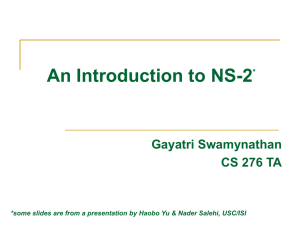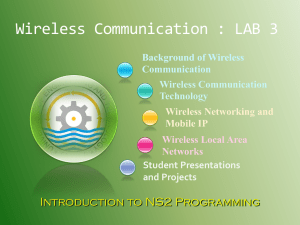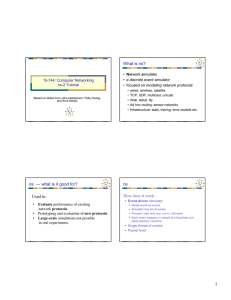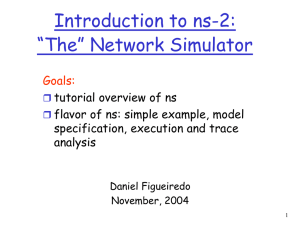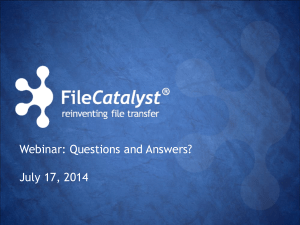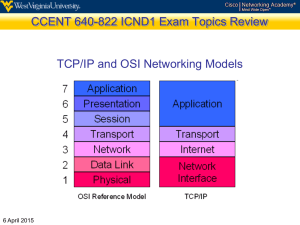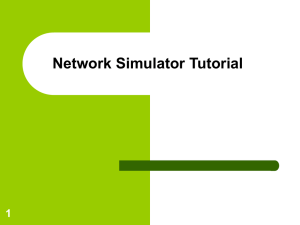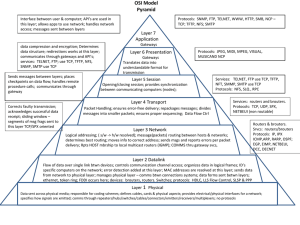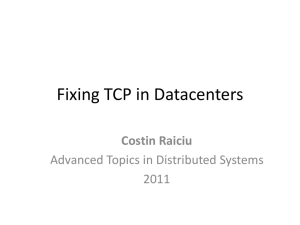Network Simulator (ns) Tutorial: A Comprehensive Guide
advertisement
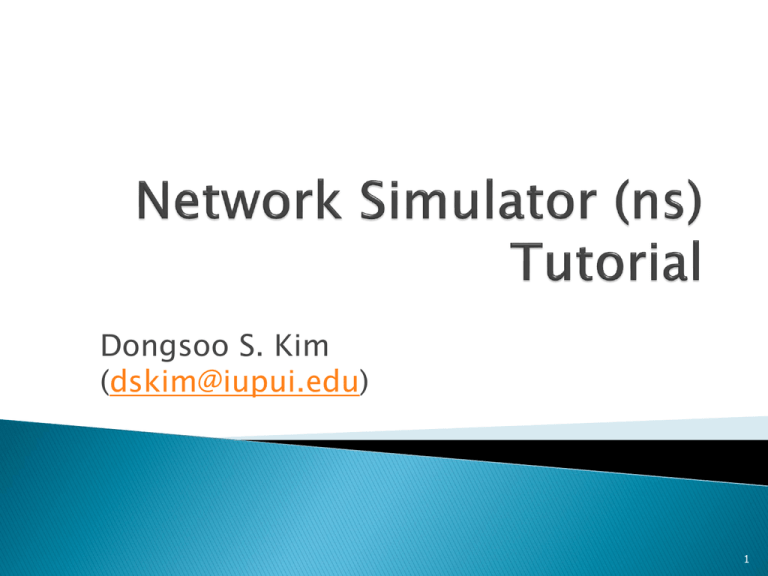
Dongsoo S. Kim
(dskim@iupui.edu)
1
Support networking research and education
Provide a collaborative environment
◦ Protocol design, traffic studies, etc
◦ Protocol comparison
◦ Freely distributed, open source
Share code, protocols, models, etc
◦ Allow easy comparison of similar protocols
◦ Increase confidence in results
More people look at models in more situations
Experts develop models
Multiple levels of detail in one simulator
2
Wired world
◦
◦
◦
◦
◦
◦
Routing DV, LS, PIM-SM
Transport: TCP and UDP
Traffic sources: web, ftp, telnet, cbr, stochastic
Queuing disciplines:drop-tail, RED, FQ, SFQ, DRR
QoS: IntServ and Diffserv
Emulation
Wireless
◦ Ad hoc routing and mobile IP
◦ Directed diffusion, sensor-MAC
Tracing, visualization, various utilities
3
Ns, the simulator itself
Nam, the network animator
◦ Visualize ns (or other) output
◦ Nam editor: GUI interface to generate ns scripts
Pre-processing:
◦ Traffic and topology generators
Post-processing:
◦ Simple trace analysis, often in Awk, Perl, Tcl,
Matlab, C, or your choice
4
Traffic models and applications:
Transport protocols:
◦ Web, FTP, telnet, constant-bit rate, real audio
◦ unicast: TCP (Reno, Vegas, etc.), UDP
◦ Multicast: SRM
Routing and queueing:
Physical media:
◦ Wired routing, ad hoc rtg and directed diffusion
◦ queueing protocols: RED, drop-tail, etc
◦ Wired (point-to-point, LANs), wireless (multiple
propagation models), satellite
5
A discrete time event-driven simulator
◦ Simple model
Focused on modeling network protocols
◦
◦
◦
◦
◦
Wired, wireless, satellite
TCP, UDP, multicast, unicast
Web, telnet, ftp
Ad hoc routing, sensor networks
Infrastructure: stats, tracing, error models, etc
6
Model world as events
◦ Simulator has list of events in a queue ordered on
time
◦ Process: take next one, run it, until the queue is
empty
◦ Each event happens in an instant of virtual
(simulated) time, but takes an arbitrary amount of
real time
Ns uses simple model
◦ single thread of control
no locking or race conditions
◦ No parallelization results in a long simulation time
7
Two nodes on a Ethernet
A
Simple
queuing
model:
B
LAN dequeues the pkt
and triggers B
A enqueues a pkt on LAN
1
1.01
Detailed
CSMA/CD A sends pkt to NIC.
A’s NIC starts carrier sense
model:
B’s NIC begins
receiving the pkt
A’s NIC concludes CS,
starts TX
B’s NIC concludes
pkt.
B’s NIC passes pkt
to app
8
Object-oriented (C++, OTcl)
Modular approach
◦ Fine-grained object composition
+ Reusability
+ Maintenance
–
–
Performance (speed and memory)
Careful planning of modularity
9
“data” / control separation
◦ C++ for “data”:
per packet processing, core of ns
fast to run, detailed, complete control
◦ OTcl for control:
Simulation scenario configurations
Periodic or triggered action
Manipulating existing C++ objects
fast to write and change
+ running
–
vs. writing speed
Learning and debugging (two languages)
10
C++
C++/OTcl
split objects
otcl
OTcl (object variant of Tcl) and C++
share class hierarchy
TclCL is glue library that makes it easy to
share functions, variables, etc
11
Class Person
# constructor:
Person instproc init {age} {
$self instvar age_
set age_ $age
}
# method:
Person instproc greet {} {
$self instvar age_
puts “$age_ years old: How are you doing?”
}
# subclass:
Class Kid -superclass Person
Kid instproc greet {} {
$self instvar age_
puts “$age_ years old kid”
}
set a [new Person 45]
set b [new Kid 15]
$a greet
$b greet
can easily make variations of existing things (TCP, TCP/Reno)
12
Class Tcl: instance of OTcl interpreter
Tcl& tcl = Tcl::instance();
tcl.evalc(“puts stdout hello world”);
tcl.result() and tcl.error
Class TclObject and TclClass
◦ Variable bindings
bind(“rtt_”, &t_rtt_)
◦ Invoking command method in shadow class
$tcp advanceby 10
13
Some important objects:
◦ NsObject: has recv() method
◦ Connector: has target() and drop()
◦ BiConnector: uptarget() & downtarget()
14
Problem
Result
analysis
Simulation
model
Modify
ns
Setup/run
simulation
with ns
15
Create the event scheduler
Turn on tracing
Create network
Setup routing
Insert errors
Create transport connection
Create traffic
Transmit application-level data
16
Create event scheduler
set ns [new Simulator]
Schedule events
$ns at <time> <event>
<event>: any legitimate ns/tcl commands
$ns at 5.0 “finish”
Start scheduler
$ns run
17
Event: at-event and packet
List scheduler: default
◦ Heap and calendar queue scheduler
Real-time scheduler
◦ Synchronize with real-time
◦ Network emulation
set ns_ [new Simulator]
$ns_ use-scheduler Heap
$ns_ at 300.5 “$self halt”
18
time_, uid_, next_, handler_
head_ ->
head_ ->
handler_ -> handle()
insert
time_, uid_, next_, handler_
19
Interactive mode:
vlsi:~ > ns
% set ns [new Simulator]
_o3
% $ns at 1 “puts \“Hello
World!\””
1
% $ns at 1.5 “exit”
2
% $ns run
Hello World!
vlsi:~ >
Batch mode:
vlsi:~ > simple.tcl
set ns [new Simulator]
$ns at 1 “puts \“Hello
World!\””
$ns at 1.5 “exit”
$ns run
vlsi:~ > ns simple.tcl
Hello World!
vlsi:~ >
20
Packet tracing:
◦ On all links: $ns trace-all [open out.tr w]
◦ On one specific link: $ns trace-queue $n0 $n1$tr
<Event> <time> <from> <to> <pkt> <size> -- <fid> <src> <dst> <seq> <attr>
+ 1 0 2 cbr 210 ------- 0 0.0 3.1 0 0
- 1 0 2 cbr 210 ------- 0 0.0 3.1 0 0
r 1.00234 0 2 cbr 210 ------- 0 0.0 3.1 0 0
◦ a new trace format is available as well.
Event tracing (support TCP right now)
◦ Record “event” in trace file: $ns eventtrace-all
E 2.267203 0 4 TCP slow_start 0 210 1
21
Queue monitor
set qmon [$ns monitor-queue $n0 $n1 $q_f $sample_interval]
◦ Get statistics for a queue
$qmon set pdrops_
◦ Record to trace file as an optional
29.000000000000142 0 1 0.0 0.0 4 4 0 1160 1160 0
Flow monitor
set fmon [$ns_ makeflowmon Fid]
$ns_ attach-fmon $slink $fmon
$fmon set pdrops_
22
Visualize trace in nam
$ns namtrace-all [open test.nam w]
$ns namtrace-queue $n0 $n1
Variable tracing in nam
Agent/TCP set nam_tracevar_ true
$tcp tracevar srtt_
$tcp tracevar cwnd_
Monitor agent variables in nam
$ns add-agent-trace $tcp $tcp
$ns monitor-agent-trace $tcp
$srm0 tracevar cwnd_
……
$ns delete-agent-trace $tcp
23
Nodes
set n0 [$ns node]
set n1 [$ns node]
Links and queuing
$ns <link_type> $n0 $n1 <bandwidth> <delay>
<queue_type>
<link_type>: duplex-link, simplex-link
<queue_type>: DropTail, RED, CBQ, FQ, SFQ, DRR,
diffserv RED queues
24
$ns make-lan <node_list> <bandwidth>
<delay> <ll_type> <ifq_type>
<mac_type> <channel_type>
<ll_type>: LL
<ifq_type>: Queue/DropTail,
<mac_type>: MAC/802_3
<channel_type>: Channel
25
Unicast
$ns rtproto <type>
<type>: Static, Session, DV, cost, multi-path
Multicast
(right after [new Simulator])
$ns mrtproto$ns multicast <type>
<type>: CtrMcast, DM, ST, BST
Other types of routing supported: source routing,
hierarchical routing
26
Creating Error Module
set loss_module [new ErrorModel]
$loss_module set rate_ 0.01
$loss_module unit pkt
$loss_module ranvar [new RandomVariable/Uniform]
$loss_module drop-target [new Agent/Null]
Inserting Error Module
$ns lossmodel $loss_module $n0 $n1
27
Link failures
◦ Hooks in routing module to reflect routing
changes
Four models
$ns
$ns
$ns
$ns
rtmodel Trace <config_file> $n0 $n1
rtmodel Exponential {<params>} $n0 $n1
rtmodel Deterministic {<params>} $n0 $n1
rtmodel-at <time> up|down $n0 $n1
◦ Parameter list
[<start>] <up_interval> <down_interval> [<finish>]
28
UDP
set udp [new Agent/UDP]
set null [new Agent/Null]
$ns attach-agent $n0 $udp
$ns attach-agent $n1 $null
$ns connect $udp $null
CBR
set src [new Application/Traffic/CBR]
Exponential or Pareto on-off
set src [new Application/Traffic/Exponential]
set src [new Application/Traffic/Pareto]
29
TCP
set tcp [new Agent/TCP]
set tcpsink [new Agent/TCPSink]
$ns attach-agent $n0 $tcp
$ns attach-agent $n1 $tcpsink
$ns connect $tcp $tcpsink
FTP
set ftp [new Application/FTP]
$ftp attach-agent $tcp
Telnet
set telnet [new Application/Telnet]
$telnet attach-agent $tcp
30
Trace driven
set tfile [new Tracefile]
set src [new Application/Traffic/Trace]
$src attach-tracefile $tfile
<file>:
Binary format (native!)
inter-packet time (msec) and packet size (byte)
31
Features
◦ Build on top of existing transport protocol
◦ Transmit user data, e.g., HTTP header
Two different solutions
◦ TCP: Application/TcpApp
◦ UDP: Agent/Message
32
More abstract (much simpler):
◦ No addresses, just global variables
◦ Connect them rather than name
lookup/bind/listen/accept
Easy to change implementation
Set tsrc2 [new agent/TCP/Newreno]
Set tsrc3 [new agent/TCP/Vegas]
33
set ns [new Simulator]
# [Turn on tracing]
# Create topology
# Setup packet loss, link dynamics
# Create routing agents
# Create:
#
- multicast groups
#
- protocol agents
#
- application and/or setup traffic sources
# Post-processing procs
# Start simulation
34
Color
Node manipulation
Link manipulation
Topology layout
Protocol state
Misc
35
Color mapping
$ns color 40 red
$ns color 41 blue
$ns color 42 chocolate
Color flow id association
$tcp0 set fid_ 40 ;# red packets
$tcp1 set fid_ 41 ;# blue packets
36
Color
$node color red
Shape (can’t be changed after sim starts)
$node shape box
;# circle, box, hexagon
Marks (concentric “shapes”)
$ns at 1.0 “$n0 add-mark m0 blue box”
$ns at 2.0 “$n0 delete-mark m0”
Label (single string)
$ns at 1.1 “$n0 label \”web cache 0\””
37
Color
$ns duplex-link-op $n0 $n1 color "green"
Label
$ns duplex-link-op $n0 $n1 label "abced"
Dynamics (automatically handled)
$ns rtmodel Deterministic {2.0 0.9 0.1} $n0 $n1
Asymmetric links not allowed
38
“Manual” layout: specify everything
$ns
$ns
$ns
$ns
duplex-link-op
duplex-link-op
duplex-link-op
duplex-link-op
$n(0)
$n(1)
$n(2)
$n(3)
$n(1)
$n(2)
$n(3)
$n(4)
orient
orient
orient
orient
right
right
right
60deg
If anything missing automatic
layout
39
Annotation
◦
Add textual explanation to your simulation
$ns at 3.5 "$ns trace-annotate \“packet drop\"“
Set animation rate
$ns at 0.0 "$ns set-animation-rate 0.1ms"
40
Getting the pieces
◦ Tcl/TK 8.x (8.3.2 preferred):
http://resource.tcl.tk/resource/software/tcltk/
◦ Otcl and TclCL:
http://otcl-tclcl.sourceforge.net
◦ ns-2 and nam-1:
http://www.isi.edu/nsnam/dist
Other utilities
◦ http://www.isi.edu/nsnam/ns/ns-build.html
◦ Tcl-debug, GT-ITM, xgraph, …
◦ Trgraph: available at
~dskim/share/Tracegraph205_unix.tar
41
Ns
and nam build questions
◦ http://www.isi.edu/nsnam/ns/ns-build.html
Ns mailing list: ns-users@isi.edu
Ns manual and tutorial (in distribution)
TCL: http://dev.scriptics.com/scripting
Otcl tutorial (in distribution):
ftp://ftp.tns.lcs.mit.edu/pub/otcl/doc/tutor
ial.html
42
